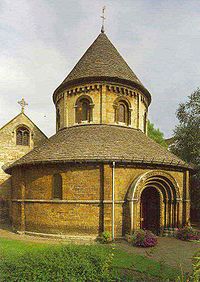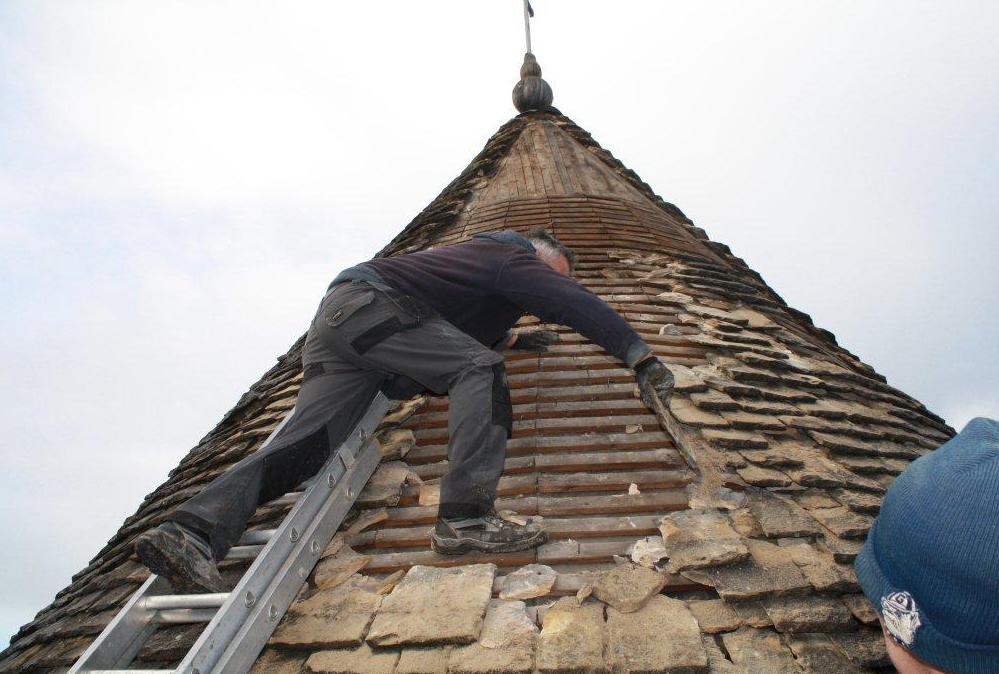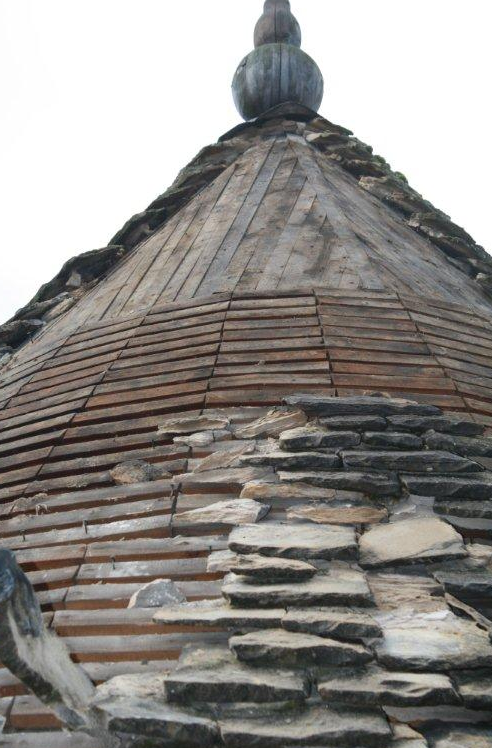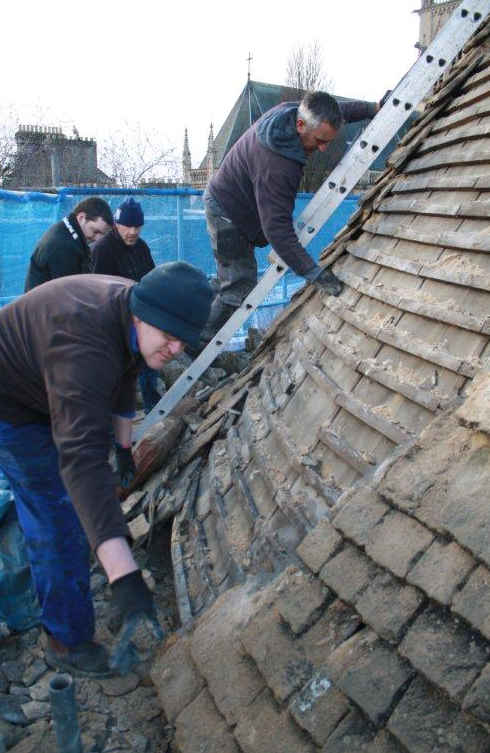Claude N Smith shortlisted for the NFRC Roofing Awards for 12th century Round Church
 Most churches in Western Europe are cross-shaped in their floor plan and in England there are only four other round churches like this one.
Most churches in Western Europe are cross-shaped in their floor plan and in England there are only four other round churches like this one.
Rocks for re-roofing the round church, or the Round Church or Holy Sepulchre, as it should be called, is a famous Cambridge church, renowned for its antiquity, visual appeal and unusual circular form. Dating from around 1130, the Round Church is one of the oldest buildings in Cambridge and is modeled on the 4th century Church of the Holy Sepulchre in Jerusalem built by the Roman Emperor Constantine.
 The Cambridge church was founded by the Norman fraternity of the Holy Sepulchre, who arrived in Britain with William the Conqueror. Impressed by the round style of the early Romanesque churches they saw in the Holy Land during the first crusade in 1097, the Normans brought the design to Europe and even as far as Cambridge. The Cambridge Round church is now just one of four surviving mediaeval round churches of this antiquity in Britain. Following substantial additions, especially a heavy 15th century tower, which subsequently threatened to collapse, the church was extensively restored to its earlier Romanesque style in the 19th century. Central to the original form is the conical roof with its beautiful stone ‘slates’, whose slight irregular texture and colour enhances the attractive picturesque look of the building.
The Cambridge church was founded by the Norman fraternity of the Holy Sepulchre, who arrived in Britain with William the Conqueror. Impressed by the round style of the early Romanesque churches they saw in the Holy Land during the first crusade in 1097, the Normans brought the design to Europe and even as far as Cambridge. The Cambridge Round church is now just one of four surviving mediaeval round churches of this antiquity in Britain. Following substantial additions, especially a heavy 15th century tower, which subsequently threatened to collapse, the church was extensively restored to its earlier Romanesque style in the 19th century. Central to the original form is the conical roof with its beautiful stone ‘slates’, whose slight irregular texture and colour enhances the attractive picturesque look of the building.
Today, the slating of a roof refers to the use of grey Welsh slates, which became prevalent in the 19th century, once Welsh slates could easily be transported around the country by boat, train and lorry. However, in earlier times the cost of transporting stone building materials was so high that any appropriate local stone was used.
 The nearest ‘slates’ to Cambridge were not slates in the true geological sense but limestones, which could be split into slabs thin enough to be used on a roof. In Early Mediaeval times, the nearest building and roofing stones had to be brought from limestone quarries in the Jurassic age hills of Oxfordshire, Lincolnshire and Northamptonshire.
The nearest ‘slates’ to Cambridge were not slates in the true geological sense but limestones, which could be split into slabs thin enough to be used on a roof. In Early Mediaeval times, the nearest building and roofing stones had to be brought from limestone quarries in the Jurassic age hills of Oxfordshire, Lincolnshire and Northamptonshire.
Barnack stone from Northamptonshire was used to build Peterborough cathedral (from A.D. 664) and subsequently became the main material for the construction of the abbeys and cathedrals of East Anglia, such as Ely Cathedral (1174-89), early Cambridge colleges, such as Corpus Christi and the Round Church. But the roof of the Round Church, required the use of Collyweston Slate from near Stamford in Lincolnshire.
 Collyweston slate has been quarried since Roman times and then was mined, once the surface outcrops of the rock became worked out and the quarrymen followed the seams of strata underground. Despite the extra cost and risk involved, Collyweston limestone can be split into remarkably thin ‘slaty’ sheets that are only around 10 mm thick and are ideal for roofing.
Collyweston slate has been quarried since Roman times and then was mined, once the surface outcrops of the rock became worked out and the quarrymen followed the seams of strata underground. Despite the extra cost and risk involved, Collyweston limestone can be split into remarkably thin ‘slaty’ sheets that are only around 10 mm thick and are ideal for roofing.
The Collyweston limestone did not form in thin sheets but has to be matured and split by the natural processes. The rock was recovered in large and relatively thick slabs, which were left outside and exposed to overwinter freezing and thawing. The development and expansion of ice crystals along the natural layering of this ancient sedimentary rock, split it into thin slabs, ideal for use as roofing ‘slates’.
However, even Collyweston slate does not last forever and after a few centuries, exposed to our grimy and corrosive atmosphere, the slate deteriorates and needs to be replaced. Lack of new supply of Collyweston slate and the high costs of working it have resulted in the replacement of Collyweston slate by the nearest equivalent limestone slate, which has the same visual appeal.
 This turns out to be Stonesfield ‘slate’, another Jurassic limestone of considerable geological interest, which originally had to be extracted from pits and underground workings. Stonesfield ‘slate’ was the source of many historically important fossils, including some of the first dinosaur remains and oldest mammal fossils. But the modern Stonesfield slate is slightly different and is now extracted from opencast quarries.
This turns out to be Stonesfield ‘slate’, another Jurassic limestone of considerable geological interest, which originally had to be extracted from pits and underground workings. Stonesfield ‘slate’ was the source of many historically important fossils, including some of the first dinosaur remains and oldest mammal fossils. But the modern Stonesfield slate is slightly different and is now extracted from opencast quarries.
The modern quarried Stonesfield ‘slate’ is over twice as thick as the Collyweston slate, which makes the roof much heavier but still produces the same visual effect. The repair and restoration of the Round Church roof has required the replacement of more than 80% of the original Collyweston slates with the new Stonesfield slate. The work has been carried out by a firm of specialist roofers still based in Collyweston, near Stamford in Lincolnshire.
The re roofing work was carried out by East of England, award winning heritage roofing specialist, Claude N Smith www.claudesmith.co.uk















